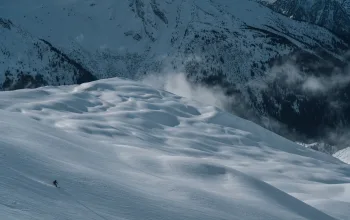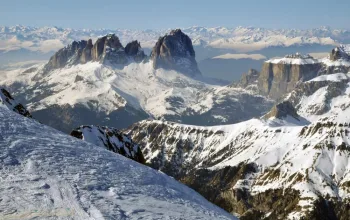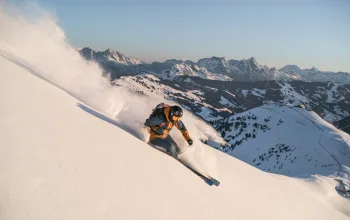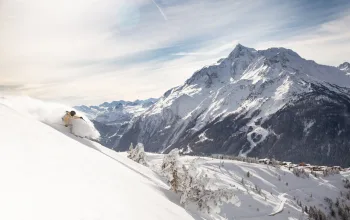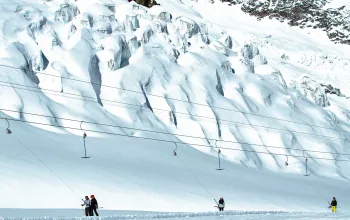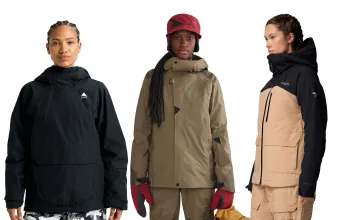Originally a seventeenth century forestry settlement, Zakopane has been a centre for Polish intellectuals for the past century. This lovely town ( with a few ugly Communist era blocks and now Burger King and McDonalds ) is also Poland's best known ski centre. There are seven ski areas around Zakopane offering more than 50 lifts between them, but most are short drag lifts, either running parallel or not connecteed to one another. Many are also privately owned lifts requiring separate tickets. The nearest ski area (3km) is Kasprowy Wierch where there is high Alpine skiing in two treeless bowls. Other nearby areas are Gubalowka and Nosal. 14 of the lifts quoted locally are drag lifts dotted around the town. Zakopane has hosted: three FIS World Ski Championships (1929, 1939,1962), three Winter Universiades (1956, 1993, 2001), Biathlon World Championship, several Ski Jump World Cups, and several Nordic Combined, Nordic and Alpine European Cups.
Mountain
Zakopane has several small skiing areas. Kasprowy Wierch, 3km from the town centre, has high alpine skiing in two treeless bowls. Skiers are transported to the top by cable car running in two sections, the first section goes up to 1350m in about 7 minutes while the second part takes skiers to the top in 10 minutes. Each of the two long slopes is served by its own one-seater chairlift. This is a National Forest Area so there is no artificial snowmaking. The best quality and amount of (artificial) snow are to be found at Nosal with its single chairlift to the top and T-bars giving access to two-thirds of the slopes. It is FIS certified slope to hold Special Slalom and Giant Slalom. Can get crowded during weekends and it is quite difficult. Some slopes are lit for night skiing. Gubalowka has snow cannons which are doing a great job of keeping the snow cover but the conditions hold up only at the top portion of the slope (it has a mountain tram going up the summit, with a capacity of 120 people) there are two T-bars at the top of the slope. Another ski-area is Bukowina Tatrzanska, it is situated about 5 km east of Zakopane and it is at much higher altitude. Snow conditions are sometimes much better. Rumours says that there have been serious investments done by the local operators of the ski lifts to establish artificial snow making and bring in new ski lifts. The city of Zakopane has FIS standard ski jumps as well as cross-country tracks. The best snow conditions are between January and late April though sometimes Kasprowy Wierch is open for skiing into early May.
Eating Out
Poland has a distinctive cuisine, with typical ingredients being dill, marjoram, caraway seeds, wild mushrooms and sour crea, which is frequently added to soups, sauces and braised meats. The national dish of Poland is bigos, made with sauerkraut, fresh cabbage, onions and leftover meat. Polish meals start with przekasi (starters) such as pike in aspic, marinated fish in sour cream, salted and rolled herring fillets with pickles and onions, kulebiak (a large mushroom and cabbage pasty) or Polish sausages such as the long, thin and highly spiced kababos or the hunters' sausage (mysliwska) made with pork and game. Soups play an important part at mealtimes and are usually rich and very thick. Soups such as barszcz (beetroot soup, excellent with sour cream)) or rosol (beef or chick bouillion) are often served in cups with small hot pasties stuffed with meat or cabbage. Popular dishes include include zrazy zawijane (mushroom-stuffed beefsteak rolls in sour cream) served with boiled kasza (buckwheat) and pig's knuckles. Poland is also a good country for fish (ryba) such as carp served in sweet and sour jellied sauc, and poached pike with horseradish in cream. Herring (sledz), is particularly popular and is served up in countless different ways. Pastries (ciastka) are also very good. Vodka (Wodka) the national drink, is drunk chilled. Wyborowa is considered the best standard vodka, but there are many flavoured varieties such as zubrowka (bison grass), tarniowka (sloe plum), sliwowica (prune) and pieprzowka (vodka with ground white pepper). Western drinks such as whisky, gin or brandy, can be obtained in most bars but are expensive. Wine is available but is imported so expensive. The best bottled beer is zywiec, a fairly strong lager type beer. Bars have table and/or counter service. Coffee shops are very popular in Poland and are the favourite meeting places from morning until late at night. They do not close during the day and have the same function as do pubs in the UK. Alcoholic drinks are available throughout the day.
Apres
All the usual apres ski activities such as sledging, floodlit skiing, skating, cross-country skiing and saunas along with a variety of lively bars. For a low-key and cosy bar, try Anemon. They have a choice of beers on tap including Irish Kilkenny, Guinness, Cashel’s cider and Budweiser (the Czech brew, not the watered-down US version). The only British-style pub in town is Paparazzi with a posh interior and refreshing drinks menu. When the weather holds, enjoy the outdoor seating next to a mountain stream. For an exceptional atmosphere visit the Piano Bar which, strangely enough, has swings at the bar! Other bars to try are Café Sanacjae and Ballada where the bartenders are said to be willing to negotiate the prices of beer. If you have the energy for dancing, try Rockus, where the DJ plays mainly hits from the 60's, 70's and 80's, or Morskie Oko, a real Zakopance hotspot with live DJ, big dance floor, flashing lights and thumping bass.
Boarding
Gubalowka has a halfpipe and plays host to national competitions.



